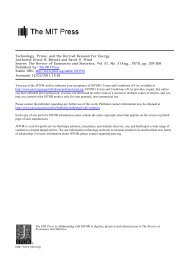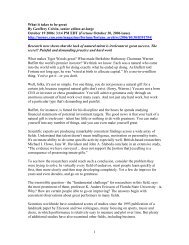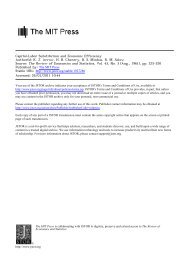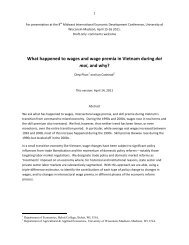Status of Wisconsin Agriculture 2010 - Agricultural & Applied ...
Status of Wisconsin Agriculture 2010 - Agricultural & Applied ...
Status of Wisconsin Agriculture 2010 - Agricultural & Applied ...
Create successful ePaper yourself
Turn your PDF publications into a flip-book with our unique Google optimized e-Paper software.
export markets, which left more milk to be absorbed by domestic markets already crimped by<br />
recession. Producers were slow to respond to lower prices. Milk production did not fall below<br />
2008 levels until mid-year, which inflated inventories <strong>of</strong> manufactured dairy products.<br />
While marginally lower than 2008, high feed prices along with sluggish domestic and foreign<br />
demand hurt the bottom line <strong>of</strong> livestock and poultry producers. Per capita U.S. meat consumption<br />
fell for the second year in a row, ending up the lowest in a dozen years. Exports <strong>of</strong> beef, pork and<br />
broilers were all <strong>of</strong>f from 2008 volumes. Total meat production fell by 3 percent, the largest yearto-year<br />
decline in 27 years, but that wasn’t enough to bolster prices in the face <strong>of</strong> lighter demand.<br />
Hog producers’ pocketbooks took the biggest hit, with hog prices down 14 percent.<br />
Although some <strong>of</strong> the crop is still in the field, USDA forecasts a record 2009/10 U.S. corn yield<br />
and a total harvest <strong>of</strong> 12.9 billion bushels, just under the previous year’s crop. Boosted by ethanol<br />
production, the industrial use <strong>of</strong> corn is expected to exceed feed use in 2009/10. <strong>Wisconsin</strong>’s corn<br />
crop is forecast at 423 million bushels, up from 2008/09 by 29 million bushels thanks to an average<br />
9 bushels/acre gain in yield. U.S. soybean yields and total crop size are both expected to set<br />
new records in the 2009/10 crop year, with a total harvest <strong>of</strong> 3.3 billion bushels. USDA says <strong>Wisconsin</strong><br />
harvested 67 million bushels <strong>of</strong> soybeans in 2009, 20 percent more than 2008.<br />
Recovering from the huge 2008 crop, <strong>Wisconsin</strong> cranberry marshes produced an 11 percent<br />
smaller crop in 2009, but higher prices will result in a smaller reduction in revenue. Apple production<br />
was up 3 percent and the tart cherry crop was close to 2007 after a near crop failure in 2008.<br />
<strong>Wisconsin</strong> grew a large fall potato crop in 2009. Unfortunately, so did other major states, causing<br />
prices to fall well under 2008 by year-end. <strong>Wisconsin</strong> processing vegetable growers produced<br />
larger crops <strong>of</strong> sweet corn and green peas in 2009, but slightly less snap bean tonnage.<br />
Prospects for <strong>2010</strong><br />
Recovery from the Great Recession has been slow and that will carry over into <strong>2010</strong>—GDP<br />
growth will not likely exceed 2.5 percent. The economy will be driven by tailwinds in the form <strong>of</strong><br />
fiscal and monetary policies designed to stimulate the economy in 2009, which will continue and<br />
perhaps become more aggressive in <strong>2010</strong>. But these will be countered by headwinds in the form <strong>of</strong><br />
high unemployment, which will limit consumer spending and, as a result, dampen business investment<br />
and new hiring. Weakness in the U.S. dollar should promote increased agricultural trade, but<br />
how much trade expands depends more on the pace <strong>of</strong> economic recovery in buying countries.<br />
Fertilizers should be even cheaper in <strong>2010</strong> than in 2009. Fuel prices are more iffy, but a major<br />
increase in crude oil prices is not visible on the horizon. Aggressive efforts by the Federal Reserve<br />
to keep interest rates low in order to promote business investment will keep the cost <strong>of</strong> credit low<br />
to farmers. But the availability <strong>of</strong> credit will be an issue in the face <strong>of</strong> tighter loan qualification<br />
standards, less money to loan, and some bankers’ reticence to make agricultural loans.<br />
Dairy farmers will fare much better in <strong>2010</strong>. The national dairy cow herd will continue to shrink<br />
for most if not all <strong>of</strong> the year. The expected 2.4 percent decline in cow numbers will more than <strong>of</strong>fset<br />
a 1.8 increase in milk per cow (the long-time trend in milk yields), reducing milk production<br />
STATUS OF WISCONSIN AGRICULTURE <strong>2010</strong>—EXECUTIVE SUMMARY v







